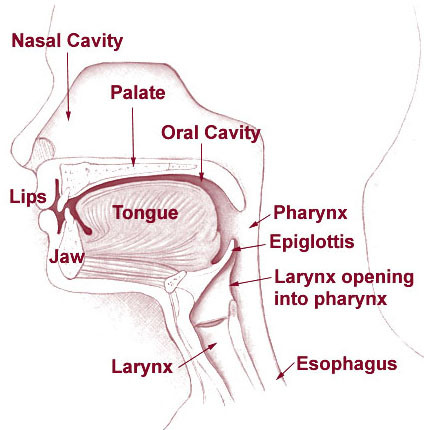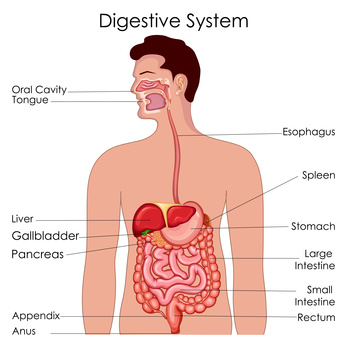Causes of Dysphagia (Difficulty Swallowing) – Mouth, Throat, Esophagus
Swallowing begins in the mouth where it voluntary. It then continues down the throat and into the esophagus. Diffculty swallowing is known as dysphagia and should not be confused with painful swallowing (odynophagia), although both symptoms may occur simultaneously. There are host of problems in the mouth, throat or esophagus that can cause dysphagia. Mouth and throat conditions that lead to difficulty swallowing are referred to as oropharyngeal dysphagia. Conditions of the esophagus that causes difficulty swallowing is known as esophageal dysphagia.
Causes of Oropharyngeal Dysphagia
Most causes of oropharyngeal dysphagia are neurological or muscular in origin, however, in infants and children it is more likely to be due to an anatomical defect or development abnormalities. Oropharyngeal dysphagia may also be referred to as high dysphagia. The signs and symptoms of the causes of dysphagia may vary depending on the severity of the condition.

Stroke
This occurs when the blood supply to part of the brain is severely reduced or stopped altogether resulting in ‘oxygen starvation’ of the brain tissue or even cell death.
- Sudden change in walking, talking and vision.
- One sided numbness and/or paralysis.
- Headache with neck stiffness.
- Extreme nausea and vomiting.
- Mental confusion or loss of consciousness.
In a mild stroke, the signs may not always be obvious, especially in a debilitated patient who is bed-ridden.
Motor Neuron Disorders
Progressive destruction of the motor neurons, those nerve cells that carry impulses to initiate and control voluntary movement. This is a group of disorders and not all motor neuron disorders will result in dysphagia.
- Muscle weakness.
- Muscle twitching and cramps.
- Muscle atrophy.
Multiple Sclerosis
Multiple sclerosis is a type of autoimmune disease where the body’s immune system attacks and destroys the insulating layer around nerves. This slows down or blocks nerve impulses.
- Tremor.
- Visual disturbances.
- Numbness and tingling of parts of the body.
- Muscle weakness.
- Dizziness.
- Lack of coordination.
Muscular Dystrophy
This is a group of genetic disorders where there is a gradual and progressive deterioration of the skeletal muscles, which are under voluntary control. The signs and symptoms may vary depending on the type of muscular dystrophy.
- Muscle weakness.
- Lack of coordination.
- Reduced range of motion of limbs in late stages.
- Difficulty breathing (dyspnea) in late stages.
Myasthenia Gravis
Myasthenia gravis is an autoimmune condition where the muscle cell’s ability to respond to the neurotransmitter, acetylcholine, secreted from neurons is impaired due to the destruction of receptor sites. Muscle weakness throughout the body is seen as difficulty with :
- Walking.
- Holding objects.
- Making facial expressions.
- Chewing.
- Swallowing.
- Sight.
- Talking.
Parkinson’s Disease
This conditions develops when there is a lack of the neurotransmitter, dopamine, in the brain.
- Resting tremor
- Slowness of movement.
- Muscle rigidity.
- Impaired balance.
- Stooping posture.
Polio
Also known as poliomyelitis, this is an infectious disease caused by the poliovirus which damages the motor neurons in the spinal cord and brain stem.
- Fever.
- Back and/or neck pain.
- Headache.
- Leg and arm pain.
- Muscle spasms.
- Loss of reflexes.
- Flaccid limbs.
Swelling
Swelling is a sign of inflammation and in severe cases, the normal swallowing action may be impaired. Swelling of the tongue, tonsils, pharynx and epiglottis may be responsible. This may be due to :
- Allergies.
- Infections.
- Toxic substances (ingested or inhaled).
- Trauma.
Tumors
Benign and malignant tumors of the mouth and throat may cause partial, or rarely complete obstruction of the oropharynx. Patients on chemotherapy and those having radiation therapy of the mouth or throat may also experience dysphagia. In terms of a malignancy (cancer), the symptoms will depend on the stage of the condition.
- Swollen lymph nodes.
- Pain at the affected area and upon swallowing.
- Bleeding.
What is esophageal dysphagia?
Dysphagia (difficulty swallowing) may stem from the oropharynx (part of the throat that communicates with the mouth) or the esophagus (food pipe). However, the swallowing process does not end once the food leaves the throat. In fact swallowing continues all the way down the esophagus (food pipe). It is therefore important to differentiate between swallowing problems stemming from the esophagus and the oropharynx (mouth-throat).
The entire swallowing process involves the action of muscles, nerves and brain centers. This ensures that muscles contractions that start in the throat continue all the way does the esophagus. However, any disruption in this process – either due to muscle, nerve or brain problems – will affect the normal movement and leads to difficulty swallowing (dysphagia).

Normal Esophageal Swallowing
The esophagus has thin muscular walls that are capable of strong contractions. These muscles contract and relax in segments to ensure that food is pushed down the esophagus to the stomach. The inner lining of the esophagus is laden with mucus secreting cells that produce large amounts of mucus as needed. The mucus serves as a lubricant to ensure the smooth and rapid transit of food pushed along the esophagus by the strong muscular contractions of its wall.
A circular collection of muscles at the bottom end of the esophagus forms a sphincter. This is known as the lower esophageal sphincter (LES). It contracts to close the entrance to the stomach and relaxes to allow food to pass through. Essentially the lower esophageal sphincter allows for only one way movement of food. This ensures that the acidic gastric contents do not pass upwards from the stomach into the esophagus.
Esophageal Dysphagia Symptoms
Dysphagia may be painless or it may be associated with pain (pain upon swallowing ~ odynophagia). With esophageal dysphagia, patients often complain of the food being stuck in the chest, whereas with oropharyngeal dysphagia, the complaint is about the throat or food does not fully exit the mouth into the throat. Chest pain may even be present in severe cases, especially if there is excessive stretching of the esophagus as food accumulated within it.
Recurrent pneumonia is a common complication of esophageal dysphagia due to aspiration of the esophageal contents. It can have life-threatening consequences, especially in debilitated and immunocompromised patients. Sometimes the respiratory symptoms associated with esophageal dysphagia is very mild. In these instances a patient may only experience a sore throat or hoarseness of the voice.
The muscular contractions associated with esophageal swallowing are primarily intended to move food down the esophagus. However, it also has an important role to play in flushing out stomach acid that may spill into esophagus. The strong contractions quickly pushes out the acid from the esophagus into the stomach. In some causes of esophageal dysphagia, this flushing out cannot be accomplished. Therefore a person is more likely to experience longer periods of heartburn and esophagitis (esophageal inflammation) associated with acid reflux.
Esophageal Dysphagia Causes
Esophageal causes of dysphagia are commonly due to neurological or muscular disorders as well as an obstruction. Muscular or neurological causes tend to affect esophageal motility while a mechanical obstruction impairs the movement of food, and even fluid if completely occluded, from reaching the stomach.
Esophageal dysphagia may arise due to pathology within the esophagus or secondary to another conditions. It may overlap with some of the causes of oropharyngeal dysphagia as the peristaltic waves that commence in the throat play a role in the peristaltic activity of the esophagus.
- Stroke
- Brain trauma
- Achalasia
- Diffuse esophageal spasms
- Parkinson’s disease
- Multiple sclerosis
- Myasthenia gravis
- Esosinophilic esophagitis
- Surgical resection of a part of the esophagus (esophagectomy)
- Esophageal cancer
- Compression from external masses like tumors, enlarged heart, aortic aneurysm
- Lower esophageal rings
References
- Dysphagia. MSD Manual





